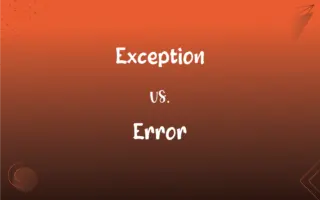Parellelogram vs. Quadrilateral: What's the Difference?
Edited by Harlon Moss || By Janet White || Published on January 31, 2024
A parallelogram is a specific type of quadrilateral with opposite sides parallel and equal, while a quadrilateral is any four-sided polygon.

Key Differences
A parallelogram is a four-sided shape where opposite sides are parallel and of equal length, and opposite angles are equal. A quadrilateral, on the other hand, is a more general term that refers to any four-sided polygon, regardless of the equality or parallelism of its sides.
In a parallelogram, the diagonals bisect each other, but are not necessarily equal. Every quadrilateral has two diagonals, but the properties of these diagonals vary greatly among different types of quadrilaterals.
Another key feature of a parallelogram is that the sum of the interior angles on each side is 180 degrees, a property shared with other quadrilaterals. However, in general quadrilaterals, the angles can vary widely as long as they sum up to 360 degrees.
A parallelogram has symmetry across its diagonals, meaning each half is a mirror image of the other. This is not a requirement for a quadrilateral, which can have an asymmetrical shape, like a trapezoid.
The classification of a parallelogram is more specific than a quadrilateral; all parallelograms are quadrilaterals, but not all quadrilaterals are parallelograms. For example, squares and rectangles are parallelograms, but kites and trapezoids are quadrilaterals that are not parallelograms.
ADVERTISEMENT
Comparison Chart
Definition
A quadrilateral with parallel opposite sides and equal opposite angles.
Any four-sided polygon.
Sides
Opposite sides are equal and parallel.
Sides may or may not be equal or parallel.
Angles
Opposite angles are equal.
Interior angles sum to 360 degrees.
Diagonals
Bisect each other but not necessarily equal.
Properties vary among different types.
Specificity
A specific type of quadrilateral.
A general category of four-sided shapes.
ADVERTISEMENT
Parellelogram and Quadrilateral Definitions
Parellelogram
A polygon where opposite angles are equal.
In this parallelogram, each pair of opposite angles measures 60 and 120 degrees.
Quadrilateral
A shape with four edges and four vertices.
This quadrilateral has two acute and two obtuse angles.
Parellelogram
A quadrilateral with diagonals that bisect each other.
The diagonals of this parallelogram bisect each other at right angles.
Quadrilateral
A polygon that can be simple or complex.
The quadrilateral we're studying has an irregular shape.
Parellelogram
A specific type of quadrilateral with two pairs of parallel sides.
This parallelogram has two pairs of parallel sides, each pair being equal in length.
Quadrilateral
A category that includes rectangles, squares, trapezoids, and kites.
Each quadrilateral in this series has unique properties.
Parellelogram
A four-sided shape with opposite sides parallel and equal.
The area of a parallelogram is calculated by base times height.
Quadrilateral
Any four-sided polygon.
A rectangle is an example of a quadrilateral.
Parellelogram
A shape used in geometry with symmetrical properties.
The parallelogram in the diagram illustrates rotational symmetry.
Quadrilateral
A term in geometry encompassing various four-sided shapes.
Squares and trapezoids are both types of quadrilaterals.
Quadrilateral
A polygon having four sides.
Quadrilateral
Having four sides.
FAQs
Can a quadrilateral have unequal sides?
Yes, a quadrilateral can have sides of different lengths.
Do parallelograms always have equal angles?
Yes, opposite angles in a parallelogram are always equal.
Are the diagonals of a parallelogram always equal?
No, the diagonals of a parallelogram bisect each other but are not necessarily equal.
Can a quadrilateral be a complex shape?
Yes, quadrilaterals can be simple or complex in shape.
What is a quadrilateral?
A quadrilateral is any four-sided polygon.
What defines a parallelogram?
A parallelogram is defined by parallel and equal opposite sides.
Can a quadrilateral be irregular?
Yes, quadrilaterals can be regular or irregular.
Are all parallelograms quadrilaterals?
Yes, all parallelograms are a subset of quadrilaterals.
Do all parallelograms have a line of symmetry?
Yes, parallelograms have lines of symmetry across their diagonals.
What's the area formula for a parallelogram?
The area of a parallelogram is base times height.
Do quadrilaterals have a specific angle sum?
Yes, the sum of angles in any quadrilateral is 360 degrees.
Is a rectangle a type of parallelogram?
Yes, a rectangle is a special type of parallelogram.
Do parallelograms have right angles?
Parallelograms can have right angles, as in rectangles.
Is a square considered a parallelogram?
Yes, a square is a specific type of parallelogram.
What types of quadrilaterals exist?
There are many, including rectangles, squares, trapezoids, and kites.
Are parallelograms always convex?
Yes, parallelograms are always convex.
Can a quadrilateral be concave?
Yes, quadrilaterals can be concave or convex.
How are the sides of a parallelogram related?
Opposite sides of a parallelogram are parallel and equal in length.
Do all quadrilaterals have parallel sides?
No, not all quadrilaterals have parallel sides.
Are all quadrilaterals symmetrical?
Not all quadrilaterals are symmetrical; it depends on their specific shape.
About Author
Written by
Janet WhiteJanet White has been an esteemed writer and blogger for Difference Wiki. Holding a Master's degree in Science and Medical Journalism from the prestigious Boston University, she has consistently demonstrated her expertise and passion for her field. When she's not immersed in her work, Janet relishes her time exercising, delving into a good book, and cherishing moments with friends and family.
Edited by
Harlon MossHarlon is a seasoned quality moderator and accomplished content writer for Difference Wiki. An alumnus of the prestigious University of California, he earned his degree in Computer Science. Leveraging his academic background, Harlon brings a meticulous and informed perspective to his work, ensuring content accuracy and excellence.







































































